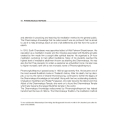Buddhist tribute : ค้นหาหนังสือธรรมะ หน้า 8 / 52
หน้าหนังสือทั้งหมด

49
Venerable Dhammajayo and his Contributions to World Peace
has also received an Honorary Doctorate Degree in Buddhist Studies from the Maha Chulalongkorn Raja Vidhayalai University.
He was the first Thai Buddhist monk to receive the Mahatma Gandhi Peace Awar
Venerable Dhammajayo has received multiple accolades for his dedication to promoting world peace through inner peace and meditation. As the first Thai Buddhist monk to receive the Mahatma Gandhi Peace

6
Creating Harmony and Understanding in Family and Society
Part Three ~ Harmony in the Family 157
Chapter 15 Creating Harmony in the Family 159
Chapter 16 What Should Parents Do When Their Children Do Not Get Along? 165
Chapter 17 Remedying the Situation When
This section explores vital aspects of family dynamics, including creating harmony, handling sibling conflicts, and instilling compassion in children toward vulnerable relatives. It further delves int

164
Understanding the Fruitful Elderly: A Guide to Altruism and Wisdom
The second type of elderly person is called “A Fruitful Person,” a philanthropist or altruist. Throughout their lives, these elderly people have diligently earned their livelihood, and are well prepar
The second type of elderly individual, termed 'A Fruitful Person', exemplifies philanthropy and self-sufficiency. These individuals have not only prepared well for their later years but have also enga

181
Understanding External and Internal Fools in Buddhism
1) External Fools include non-Buddhists. They are determined to demolish Buddhism, whether they are of other religious affiliations or not. They typically try to cast aspersions upon Buddhist monks. W
In Buddhism, External Fools are non-Buddhists who seek to distort and undermine Buddhist teachings, casting aspersions on monks and creating confusion. Internal Fools, on the other hand, are Buddhists

55
English for Buddhism Lovers
English for Buddhism Lovers
เรื่อง : ดร.อภิคร รถวาคู
artwork : แนว
ช่วงนี้เป็นช่วงฤดูลากเข้าสงที่พวกเราคงจะตั้งใจเพิ่มพูนบุญกุศล โดยการทำความดีการให้มากขึ้นใช่ไหมคะ เช่น ปฏิบคยรักศีล 5 ถึงใจที่จะรัก
During the rainy season, we focus on increasing our good deeds and following precepts. This article provides English vocabulary related to Buddhist practices, including the five and eight precepts, en

13
Preservation of Mes Aynak: A Plea from WFBY
WORLD FELLOWSHIP OF BUDDHIST YOUTH
61/6 Benajamin Park, Sukhumvit 24
Bangkok, Thailand 10110
Tel +66 87 502 6358 Fax +662 534 0270
November 13th, 2012
Our Ref: WFBY 36/2555
Mr Gwang-Jo Kim
DIRECTO
The World Fellowship of Buddhist Youth (WFBY) has formally requested UNESCO to intervene against the planned copper mining at Mes Aynak, a site of crucial cultural and historical significance dating b

49
The Tathāgata and Brahmā: A Semantic Analysis
1. The Tathāgata and Brahmā,48 the creator god
2. The Tathāgata's mouth (verbal teaching) & Brahmā mouth.
3. The dhamma and Brahmā, the creator god; or
The dhamma and Brahman, the ultimate reality.
I
This passage delves into the nuanced relationships between the Tathāgata and Brahmā, highlighting the semantic layers present in verbal teachings. It contrasts the Tathāgata's mouth with Brahmā's, ind

57
The Concept of Dhamma and Kāya in Buddhist Philosophy
On the whole, it appears that the terms dhamma and brahma constituting four designations of the Tathāgāta are used in the sense of the ‘highest.’ It is most likely that they refer to Nibbāna.
This i
This study examines the terms dhamma and brahma, suggesting that they refer to the highest aspect of Tathāgāta, likely Nibbāna. The term dhamma denotes transcendental realities, transcending the realm

85
Academic Studies on Buddhism
Mus, Paul. Barabudur: Sketch of a History of Buddhism Based on Archaeological Criticism of the Texts. New Delhi: Indira Gandhi National Centre for the Arts: Sterling Publishers, 1998.
Need, David Nort
This collection features key academic contributions to the study of Buddhism, drawing from archaeological criticism, doctrinal analyses, and comparative studies between traditions. Works by notable sc

134
Exploring Daoist and Buddhist Visualization Techniques
The second one is the "Golden Palace" which is located below the heart and spleen, and the last field is the "Mud Pill Court" or the Palace of Ni-wan which is located about three inches within the hea
The text discusses the Golden Palace and the Mud Pill Court in relation to Daoist meditation. It highlights the visualization techniques associated with the cinnabar field, emphasizing its significanc

135
Buddhist Influence on Daoist Visualization Techniques
meditation. Lokakṣema translated Foshou banzhou sanmei jing 佛說般若三昧經 Pratyutpanna Samadhi-sūtra or “The Samadhi of Being in the presence of all the Buddhas”, which is the Visualization of Buddha or Bud
This text discusses the translation of Buddhist sutras like the Pratyutpanna Samadhi-sūtra and their influence on Daoist visualization techniques. It highlights how practices such as Buddhānusmṛti and

136
The Influence of An Shigao on Meditation in Eastern Han China
Conclusion
In conclusion, in this paper I have reviewed An Shigao's career as a meditation master and a translator of Buddhist texts. Based on his translations of meditation sutras I have argued that
In this conclusion, I highlight An Shigao's significant contributions as a meditation master and translator of Buddhist texts. His translation of meditation sutras introduced mindfulness breathing med

18
Buddhist Symbolism and Art
Some of the visible text in the images includes:
- "OM" (partially visible on a cloth on the table in the first image)
- "Buddhist" (partly visible on the cloth in the first image)
- A television scr
This content explores the significance of Buddhist symbols in art and culture, highlighting demonstrations and displays featuring the revered 'OM' symbol and other elements of Buddhist tradition. The

253
Buddhism Studies and Literature
Sam Nhean. (1957). The History of Buddhism in Cambodia. Phnom Penh : TraiRat
Saddhātissa, H. 1990. Pāli Literature of South-East Asia. Singapore: Singapore Buddhist Meditation Centre.
Sehrai, Fidaulla
This text contains references to significant works in the study of Buddhism, including historical accounts, Pāli literature from Southeast Asia, and studies on the influence of Indian Buddhism and its

577
The Interfusion of Chinese and Indian Cultures in Central Asia
Visualization of the Buddhas: The Interfusion of the Chinese and Indian Cultures in Central Asia as Reflected in a Fifth Century Apocryphal Sutra." PhD Dissertation. Yale University. Yamabe, Nobuyoshi
This dissertation examines the merging of Chinese and Indian influences in Central Asia, particularly through apocryphal Buddhist texts. It also discusses various publications that delve into Buddhist

111
หลักฐานธรรมาภายในคัมภีร์พุทธโอวาท 1
หลักฐานธรรมาภายในคัมภีร์พุทธโอวาท 1 ฉบับรวบรวมงานวิจัยโดยอ้อ
Hoernle, A.F.R., F.E Pargiter, and Sten Konow. 1916. Manuscript Remains of Buddhist Literature Found in Eastern Turkestan: Facsimiles with
เอกสารนี้เป็นการรวบรวมและทำการวิจัยเกี่ยวกับคัมภีร์พุทธโอวาท รวมถึงการศึกษาเอกสารที่พบในตุรกีตะวันออก ขอบเขตเนื้อหาครอบคลุมถึงพระสูตรและการศึกษาโลกรู้ของนิกายมหายาน เช่น คัมภีร์ ลังกาวาตาระและทบทวนควา

20
History of Wat Phra Dhammakaya and Key Figures
1884-1959
The Great Master Phramongkolthepmuni, Abbot of Wat Paknam. Discoverer of the Dhammakaya Meditation Method.
1909-2000
Khun Yai Chand Khonnokyoong, founder of Wat Phra Dhammakaya (the Dhammak
The history of Wat Phra Dhammakaya traces its origins to influential figures such as Phramongkolthepmuni, the Great Master and discoverer of the Dhammakaya Meditation method. Khun Yai Chand Khonnokyoo

48
Phramongkolthepmuni: A Legacy of Dhammakaya Meditation
44 PHRAMONGKOLTHEPMUNI
and attention in practicing and teaching his meditation method to the general public.
The Dhammakaya Knowledge that he rediscovered was so profound that he aimed
to use it to h
Phramongkolthepmuni, originally Sodh Chandasaro, became abbot of Wat Paknam Bhasicharoen in 1918. Known for his meditation mastery, he organized workshops leading many to attain the Dhammakaya level.

159
Glossary of Buddhist Terms
GLOSSARY 155
Dhamma (Skt. Dharma): the truth; the natural condition of things or beings; the law of their existence; the ethical code of righteousness; the whole body of religious doctrines as a sys
This glossary outlines significant Buddhist terms. Dhamma refers to truth and the natural law of existence as taught by the Buddha. Dhammacakkappavattana Sutta is recognized as the Buddha's first teac

165
Exploring Concepts in Buddhism and Mindfulness
Sanskrit: another ancient language used in India; Buddhist scriptures in Sanskrit are translated from the Pali language; Sanskrit texts are used by the Mahayana school of Buddhism.
Seventh Base of th
This text delves into the significance of Sanskrit as an ancient language in India and its relation to Buddhist texts, particularly those influenced by the Mahayana school. It introduces the Seventh B
